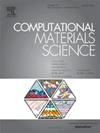Dislocation stress-field and solute-strengthening predictions based on minimal ab-initio input
IF 3.3
3区 材料科学
Q2 MATERIALS SCIENCE, MULTIDISCIPLINARY
引用次数: 0
Abstract
Solid solution strengthening is a powerful strategy for enhancing the yield strength of materials through alloying. Recent theories have effectively predicted solute-strengthening effects, but their application relies on the accurate characterization of the dislocation core and the solute/dislocation interaction energy map. In this study, starting from minimal DFT input we employ the Peierls–Nabarro model in combination with Stroh’s dislocation theory to model the dislocation core and stress field, and subsequently derive interaction energy maps. The interaction energy maps are then used to predict the critical resolved shear stress in alloys. This approach is tested on materials with different crystal structures (HCP and FCC), for dislocations with both narrow and wide cores, and for crystals with isotropic and anisotropic elastic properties. Our results are carefully validated against molecular statics simulations, to analyze the robustness and accuracy of the method, and to highlight its limitations and possible directions of improvement. We identify best modeling practices and apply them to predict solute strengthening effects ab initio, comparing our predictions with experimental data. The approach produces good results for Mg–Zn and Zn–Cu alloys, showing reasonable agreement with experimental strengthening trends and capturing the key physical mechanisms. These findings demonstrate that ab initio predictions of solute strengthening are achievable with satisfactory accuracy while maintaining minimal computational cost, providing an efficient framework for future studies.

基于最小从头算输入的位错应力场和溶质强化预测
固溶强化是通过合金化提高材料屈服强度的有效策略。最近的理论已经有效地预测了溶质强化效应,但它们的应用依赖于位错核心的准确表征和溶质/位错相互作用能图。在本研究中,我们从最小DFT输入出发,采用Peierls-Nabarro模型结合Stroh的位错理论对位错核和应力场进行建模,并推导出相互作用能量图。然后用相互作用能图来预测合金的临界分解剪应力。该方法在具有不同晶体结构的材料(HCP和FCC)、窄芯和宽芯的位错以及具有各向同性和各向异性弹性性能的晶体上进行了测试。我们的结果与分子静力学模拟进行了仔细验证,分析了该方法的鲁棒性和准确性,并强调了其局限性和可能的改进方向。我们确定了最佳的建模实践,并将其应用于从头开始预测溶质强化效应,并将我们的预测与实验数据进行了比较。该方法对Mg-Zn和Zn-Cu合金的强化效果较好,与实验强化趋势基本一致,并捕捉到了关键的物理机制。这些发现表明,在保持最小计算成本的同时,从头开始预测溶质强化可以达到令人满意的精度,为未来的研究提供了有效的框架。
本文章由计算机程序翻译,如有差异,请以英文原文为准。
求助全文
约1分钟内获得全文
求助全文
来源期刊

Computational Materials Science
工程技术-材料科学:综合
CiteScore
6.50
自引率
6.10%
发文量
665
审稿时长
26 days
期刊介绍:
The goal of Computational Materials Science is to report on results that provide new or unique insights into, or significantly expand our understanding of, the properties of materials or phenomena associated with their design, synthesis, processing, characterization, and utilization. To be relevant to the journal, the results should be applied or applicable to specific material systems that are discussed within the submission.
 求助内容:
求助内容: 应助结果提醒方式:
应助结果提醒方式:


